Why is it necessary to form cucumbers in a greenhouse and how to produce it correctly
When planting various vegetables in greenhouses, every gardener knows that in addition to light and water, they require additional care. Cucumbers are no exception. Along with traditional soil preparation and daily watering, it is important to properly form cucumber bushes. This will allow you to get an excellent harvest and achieve high fruiting.
We’ll look at how to grow cucumbers in a greenhouse below.
What is this procedure and why do cucumbers need it?
Bushes are formed not only for the sake of order in the beds, but also to protect plants from various diseases, as well as access to fresh air and light to the fruits.
When growing, it is recommended pinch resulting branches. When cucumbers are grown in open ground, they do not need to be shaped, provided that the bushes are located at a large distance from each other.
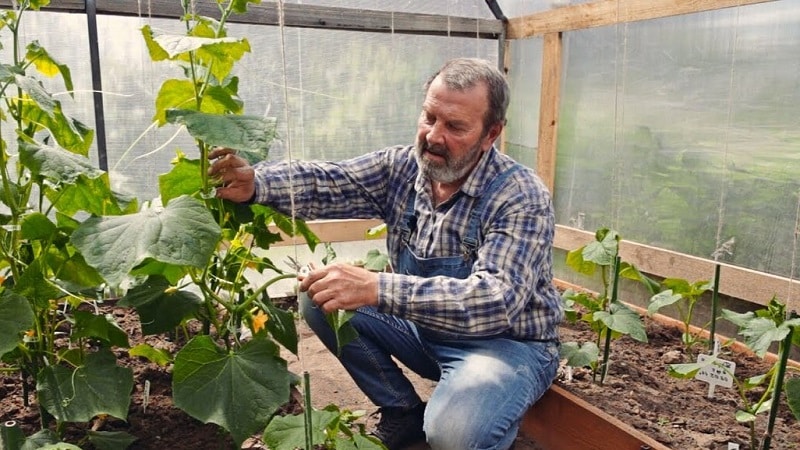
The formation of cucumbers in a greenhouse is necessary for the following reasons::
- Uncontrolled growth and formation of new ovaries leads to the fact that the root system cannot cope, the plant is unevenly saturated with nutrients and moisture. As a result, the quality of the fruit is significantly reduced. The cucumbers will be small, uneven, and tasteless.
- Thickets limit the access of insects to flowers for further pollination.
- When a source of disease appears, all bushes are instantly infected, increasing the risk of losing the entire crop.
- It is easier for gardeners to weed, water the soil and harvest from formed bushes.
Most varieties require staking. A support is installed near each bush so that the stem wraps around it and does not lie on the ground, otherwise the plant will get sick or rot.
When to form cucumbers in a greenhouse
It is important to know what pattern to form the bushes and how to properly remove ripe fruits. All this affects the quality and volume of the harvest. If you leave the cucumbers unattended, one part of the crop will die, and the second will not be of the best quality.
When the first 5-6 leaves appear on the garden bed, feel free to begin forming bushes. If they reach a height of 20 cm, time will be lost.
Formation options
There are several types of formation, which depend on:
- varieties of cucumbers, vine length, degree of branching;
- growing conditions - in open ground or greenhouse.
Based on this, the type of support and formation method are selected:
- in one stem;
- in several stems;
- "herringbone"
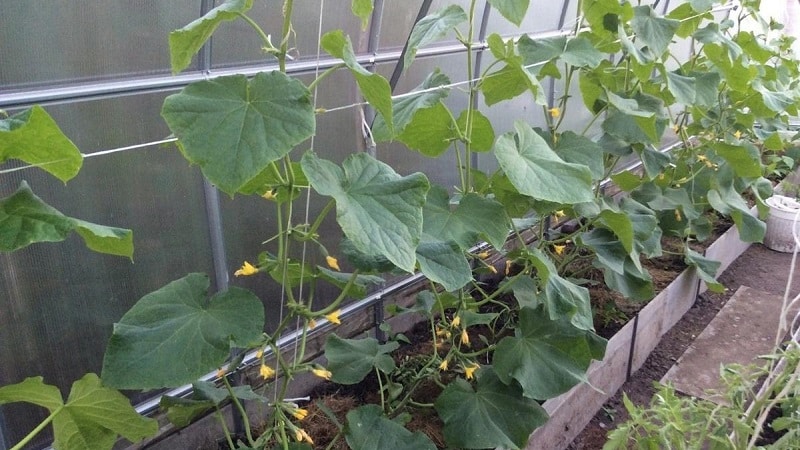
How to shape cucumbers correctly
Before choosing a method for forming cucumber bushes, pay attention to the variety. The fundamental criterion is the degree of branching and the length of the vine. Actively growing shoots are tied up and thinned out, otherwise they block each other and the access of insects to the flowers.
Required materials and tools
Materials for creating supports:
- Wooden beams 1-2 meters long.
- Copper wire, soft twine and ropes.
- Unnecessary scraps of rags for tying up bushes.
- Wooden slats of different lengths.
Wrap the main stem only with twine, which does not injure the plant during growth.
Important! Do not use thin wire, threads or various fishing lines, which, when pulled, will cut the stem.
Required Tools:
- Scissors for cutting wire.
- Pliers, hammer and any nails.
- A sledgehammer for driving pegs into the ground.
Schemes and step-by-step instructions with photos
Let's consider methods for forming a cucumber bush into one or several stems.
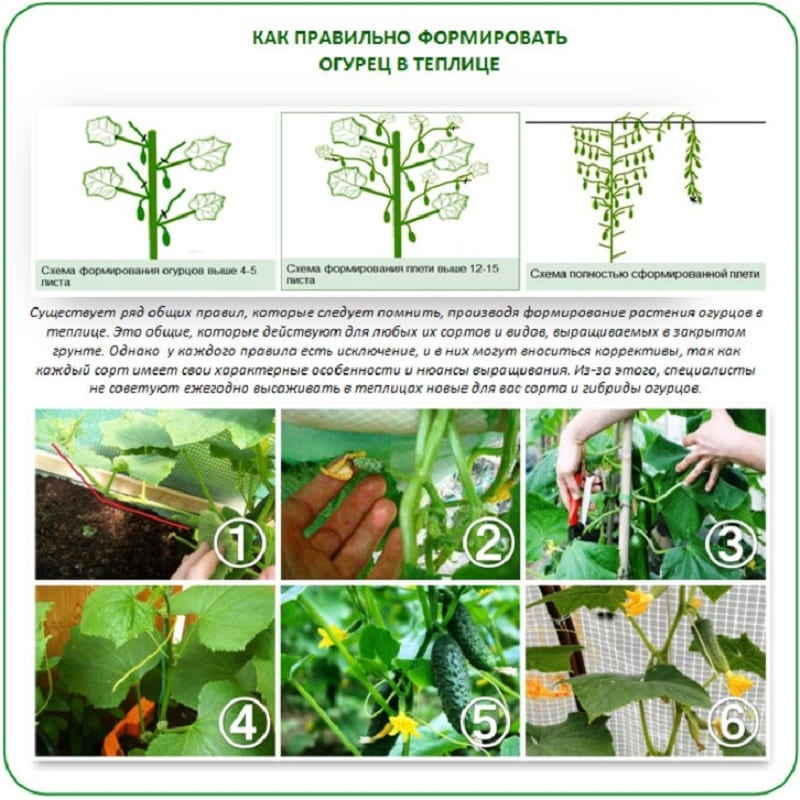
Formation into one stem
The scheme is suitable for growing cucumbers in closed greenhouses:
- Place a support near the bushes.
- After forming 5-6 leaves, loosely tie the bush to the crossbar.
- When the first shoots appear, pinch them until the bush reaches 50 cm. All nutrients will go to the development of ovaries and fruit growth, and not just to the root system. By freeing the lower tier, you will protect the plant from contact with the soil surface and possible diseases.
- At a distance of 50 cm, leave two ovaries next to every third leaf, at the very top - three near every fourth leaf. Subsequently, an even bush is formed.
By choosing this method of formation, you get good yield and fruitfulness.
Formation into several stems
Using this method, cucumbers grow very quickly.. Timely thinning is necessary: too large leaves will not allow the vegetables to fully ripen.
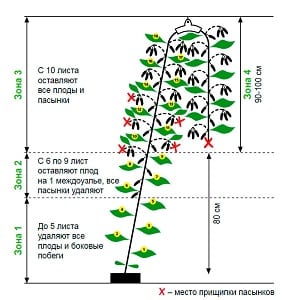 Rules for forming a bush with several stems:
Rules for forming a bush with several stems:
- Tie the main stem to the trellis using a rope without pulling it.
- Before the first ovaries appear, pinch the top of the bush.
- Side shoots cannot be removed; they are tied up and pulled towards the main stem at an angle. This will create a beautiful bush without damaging the shoots.
- Wrap the tendrils from the side shoots around the main stem. This will strengthen the bush and prevent it from interfering with neighboring plants.
It can be useful:
How to properly water cucumbers with soda and what benefits it will bring
How is potassium nitrate useful for cucumbers during fruiting?
Features of the formation of parthenocarpic varieties
When choosing seeds, pay attention to what type the variety is. cucumbers:
- insect-pollinated;
- parthenocarpic (self-pollinating).
Main difference - a female flower on self-pollinating varieties, with ovaries in the form of a small cucumber. These varieties do not require pollination assistance from insects or humans.
At the time of planting seedlings To tie up the bushes, prepare twines hanging from above. Do not overtighten so that the plants do not pull out of the soil. Wrap the stem loosely around the support, preferably under each leaf, so that in the future it does not break off under the force of the gravity of the fruit.
Remove side shoots, flowers and ovaries from the lower tiers. When the bush reaches 30 cm, pinch the side shoots to 5-6 leaves. Next - above the first leaf of each ovary.
When the cucumber vine reaches the crossbar, it is thrown over and it grows downwards. Pinching is done already on 2-3 leaves. When 1 meter remains between the soil and the vine, it is pruned, stopping growth.
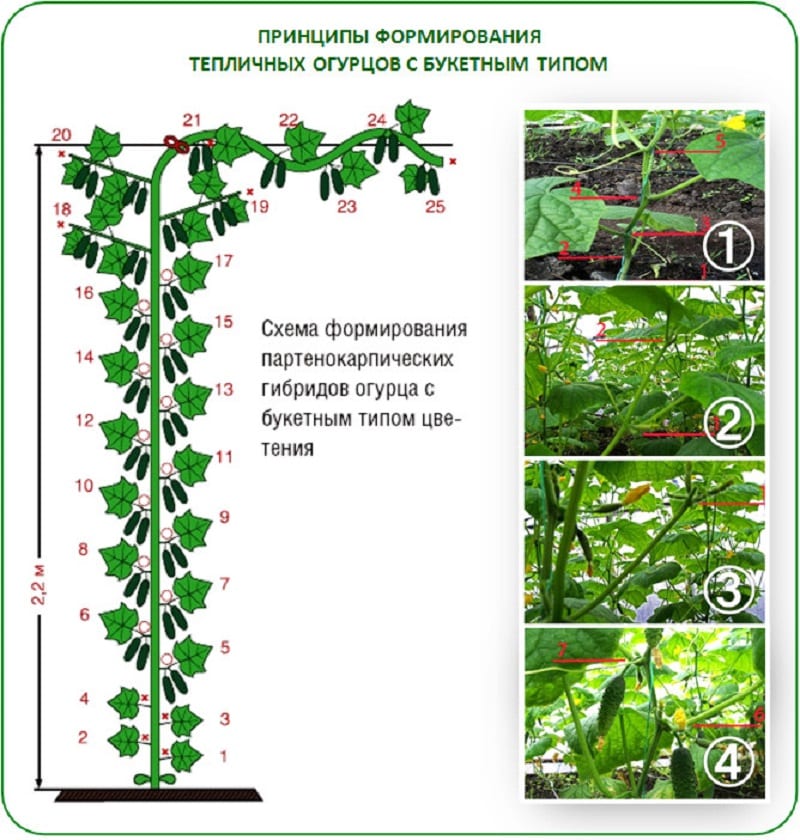
Features of the formation of bee-pollinated varieties
Insect-pollinated plants have male flowers. (barren flowers), incapable of independent formation of ovaries without the participation of bees or humans.
During the flowering period create access for insects or carry out pollination yourself. To attract bees, make a solution based on honey or jam and spray the bushes.
There is no need to pinch the main stem, it should reach the top crossbar. In the area of the lower 4-5 leaves, all flowers and ovaries are removed. From 5-7 leaves shoots up to 20 cm are left. Then the length is increased. In the area of the crossbar itself, the shoots reach 50 cm. Having entwined the crossbar with the main stem, pinching is done.
Prevent the growth of impenetrable vines. Such plantings are poorly lit, and insect access will be difficult. Insufficient ventilation will cause bush disease.
In case of insufficient pollination of bushes by bees pick the male flower and touch it to the female one (it has a small ovary).
Attention! Perform all manipulations in the morning, while it is not very hot. The process is long and monotonous, but it is worth the effort.
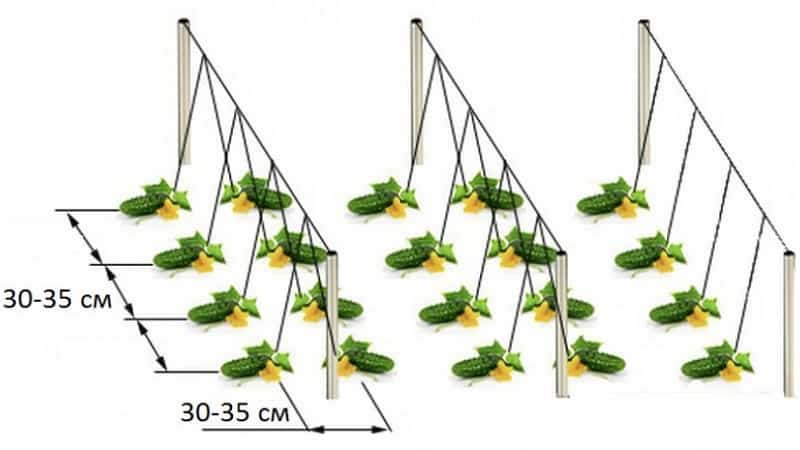
Nuances of formation in a greenhouse
Growing outdoors and indoors are very different.. In the first case, the bush grows horizontally, in the second – vertically.
With horizontal growth, vines are located along the ground, and the foliage creates a special microclimate. The pinching process is impractical and will cause bush diseases. To prevent cucumbers from growing too much, it is more effective to pinch the main shoot.
If you observe a large number barren flowers, pinch the main stem and partially the side branches. This promotes the growth of second-order branches that will contain female flowers.
Vertical growing is typical for indoor greenhouses. Formation is carried out in one or several stems. As a result, the bush is better illuminated and does not occupy large areas.
Don't forget to ventilate the greenhouse for good ventilation and saturation of plants with oxygen. Provide access to bees and bumblebees that will pollinate cucumber bushes. Water them in the morning, remove dried and diseased leaves.
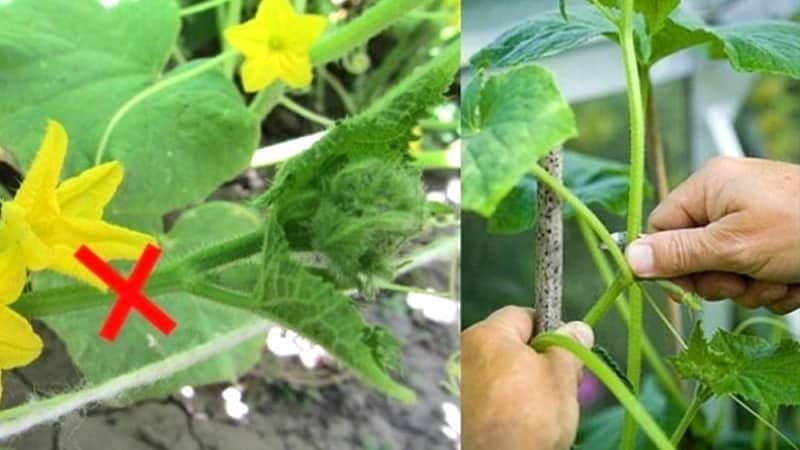
Advantages and disadvantages of the procedure
Shaping eliminates cucumber bushes from all sorts of problemswhich interfere with obtaining a high-quality harvest. This makes it easier to care for plantings and promotes high yields thanks to:
- formation of optimal load on the root system;
- effective ventilation of plants;
- good lighting and uniform saturation with moisture of all layered sheets and the fruits themselves;
- ease of caring for cucumber bushes;
- timely prevention of diseases;
- increased fruiting;
- comfortable harvesting of the ripe harvest.
If we neglect the formation, then:
- the ovaries turn yellow and fall off due to lack of nutrients;
- the fruits do not ripen and have an irregular shape;
- productivity decreases;
- the risk of disease increases.
Conclusion
Proper formation of cucumber bushes is the key to a good harvest and high fruiting. This way you will create comfortable conditions for plant growth, protect them from diseases, facilitate the process of caring for the crop, and most importantly, you will delight yourself and your family with fragrant and juicy cucumbers!